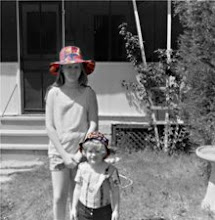 How will you be celebrating Summer Solstice this year? Dancing and singing under a star lit sky around a bonfire? Celebrating with a summer concert in the park or going to an outdoor amphitheater for Shakespeare's Midsummer Night's Dream? Whatever your plans are, I just hope you do have plans to celebrate. It seems in today's society, celebrations of our ancient ancestors, like summer solstice, get lost through the ages. We still recognize our major holidays, but with our busy schedules and standard paid vacations, we tend to forget about celebrating the smaller nuances of life, such as the longest day of the year.
How will you be celebrating Summer Solstice this year? Dancing and singing under a star lit sky around a bonfire? Celebrating with a summer concert in the park or going to an outdoor amphitheater for Shakespeare's Midsummer Night's Dream? Whatever your plans are, I just hope you do have plans to celebrate. It seems in today's society, celebrations of our ancient ancestors, like summer solstice, get lost through the ages. We still recognize our major holidays, but with our busy schedules and standard paid vacations, we tend to forget about celebrating the smaller nuances of life, such as the longest day of the year. This year Summer Solstice falls on June 21st, the day summer officially begins. It is a time to reflect upon the passing of the first half of the year and to renew yourself for the second half to come. In earlier times, summer was viewed as a joyous time of the year. The snow had melted, temperatures warmed, and the earth was blooming. Food was easier to find, crops had already been planted, and some herbs were ready to be harvested for medicine and other uses. Even in ancient times they were able to determine that days began to shorten and this was the longest day or shortest night of the year.
This year Summer Solstice falls on June 21st, the day summer officially begins. It is a time to reflect upon the passing of the first half of the year and to renew yourself for the second half to come. In earlier times, summer was viewed as a joyous time of the year. The snow had melted, temperatures warmed, and the earth was blooming. Food was easier to find, crops had already been planted, and some herbs were ready to be harvested for medicine and other uses. Even in ancient times they were able to determine that days began to shorten and this was the longest day or shortest night of the year.  Summer Solstice has been celebrated by many societies in the northern hemisphere. The ancient Celts, or Druids, celebrated Alban Heruin or "Light of the Shore". In ancient China, the summer solstice ceremony celebrated the earth, the feminine, and the yin forces. This complemented the winter solstice that celebrated the heavens, masculinity and yang forces. Ancient Gaul's midsummer celebration was called Feast of Epona, a mare goddess who embodied fertility, sovereignty and agriculture. Ancient Rome held the festival of Vestalia, to honor the Roman Goddess of the hearth, Vesta. A midsummer tree was set up and decorated in each village in ancient Sweden and villagers would dance around it. They also had a magical ritual where the women and girls would bathe in the local river to bring rain for the crops. Ancient Pagans celebrated with bonfires or fire festivals. Pairs of lovers would jump through flames, and it was believed that the crops would grow as high as the couples could jump. The fires were also thought to bring more energy to the sun so that it would remain potent throughout the growing season to yield a plentiful harvest. This was also the traditional month for weddings, between planting and harvesting of the crops. The Pagans believed the month of May was for the union of the Goddess and God, at Beltaine. It was believed to be unlucky to compete with the deities and many couples delayed their unions until June. After the conversion to Christianity in Europe, the feast day of St. John the Baptist was set on June 24th. The Native Americans also celebrated this time with ceremonies and created countless stone structures linked to the equinoxes and solstices.
Summer Solstice has been celebrated by many societies in the northern hemisphere. The ancient Celts, or Druids, celebrated Alban Heruin or "Light of the Shore". In ancient China, the summer solstice ceremony celebrated the earth, the feminine, and the yin forces. This complemented the winter solstice that celebrated the heavens, masculinity and yang forces. Ancient Gaul's midsummer celebration was called Feast of Epona, a mare goddess who embodied fertility, sovereignty and agriculture. Ancient Rome held the festival of Vestalia, to honor the Roman Goddess of the hearth, Vesta. A midsummer tree was set up and decorated in each village in ancient Sweden and villagers would dance around it. They also had a magical ritual where the women and girls would bathe in the local river to bring rain for the crops. Ancient Pagans celebrated with bonfires or fire festivals. Pairs of lovers would jump through flames, and it was believed that the crops would grow as high as the couples could jump. The fires were also thought to bring more energy to the sun so that it would remain potent throughout the growing season to yield a plentiful harvest. This was also the traditional month for weddings, between planting and harvesting of the crops. The Pagans believed the month of May was for the union of the Goddess and God, at Beltaine. It was believed to be unlucky to compete with the deities and many couples delayed their unions until June. After the conversion to Christianity in Europe, the feast day of St. John the Baptist was set on June 24th. The Native Americans also celebrated this time with ceremonies and created countless stone structures linked to the equinoxes and solstices. If you don't have any plans to build a bonfire or there are no concerts or outdoor plays to be found, you could still plan a picnic in the park, dinner in your backyard, or a leisurely evening stroll around the neighborhood. Perhaps even just a glass of wine or cup of tea on your porch step, staring aimlessly into the horizon, reflecting on what has been and dreaming of what is to come. Happy Summer Solstice!
If you don't have any plans to build a bonfire or there are no concerts or outdoor plays to be found, you could still plan a picnic in the park, dinner in your backyard, or a leisurely evening stroll around the neighborhood. Perhaps even just a glass of wine or cup of tea on your porch step, staring aimlessly into the horizon, reflecting on what has been and dreaming of what is to come. Happy Summer Solstice!For more information on Summer Solstice and its history, here are some great links to check out:
http://www.schooloftheseasons.com/midsummer.html
http://www.netglimse.com/holidays/summer/summer_solstice_celebration.shtml
http://www.equinox-and-solstice.com/html/summer_solstice.html
http://www.religioustolerance.org/summer_solstice.htm
http://www.serve.com/shea/germusa/midsumm.htm
http://www.americanspiritnews.com/JJ95/Html/SummerSolstice.html
http://www.americanspiritnews.com/MJ96/SummerSolstice.html
http://www.circlesanctuary.org/pholidays/summersolstice.htm







No comments:
Post a Comment